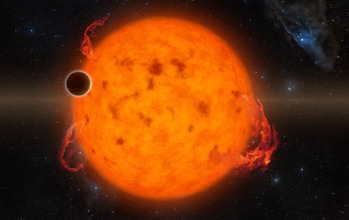All Images
News Release 16-083
Multiple suns and young planets: NSF-supported graduate researchers lead exoplanet discoveries
Early-career astronomers detect new worlds unlike any detected thus far
This material is available primarily for archival purposes. Telephone numbers or other contact information may be out of date; please see current contact information at media contacts.

This artist's impression shows a view of the triple-star system HD 131399 from close to the giant planet orbiting in the system. The planet is known as HD 131399Ab and appears at the lower left of the picture. Located about 320 light-years from Earth in the constellation of Centaurus (The Centaur), HD 131399Ab is about 16 million years old, making it also one of the youngest exoplanets discovered to date, and one of very few directly imaged planets. With a temperature of around 580 degrees Celsius and an estimated mass of four Jupiter masses, it is also one of the coldest and least massive directly-imaged exoplanets.
Credit: ESO/L. Calçada
Download the high-resolution JPG version of the image. (67.8 KB)
Use your mouse to right-click (Mac users may need to Ctrl-click) the link above and choose the option that will save the file or target to your computer.

K2-33b, shown in this illustration, is one of the youngest exoplanets detected to date and makes a complete orbit around its star in about five days. These two characteristics combined provide exciting new directions for planet-formation theories. K2-33b could have formed on a farther out orbit and quickly migrated inward. Alternatively, it could have formed in situ, or in place.
Credit: NASA/JPL-Caltech/R. Hurt
Download the high-resolution JPG version of the image. (1.5 MB)
Use your mouse to right-click (Mac users may need to Ctrl-click) the link above and choose the option that will save the file or target to your computer.
_f.jpg)
This graphic shows the orbit of the planet in the HD 131399 system (red line) and the orbits of the stars (blue lines). The planet orbits the brightest star in the system, HD 131399A.
Credit: ESO
Download the high-resolution JPG version of the image. (72.4 KB)
Use your mouse to right-click (Mac users may need to Ctrl-click) the link above and choose the option that will save the file or target to your computer.


